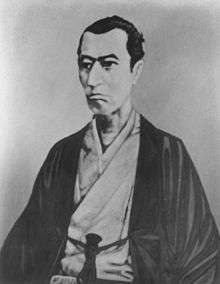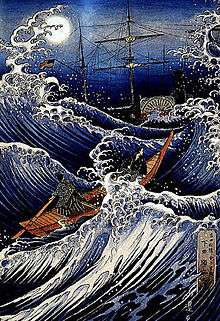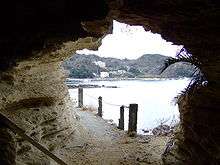Yoshida Shōin
| Yoshida Shōin | |
|---|---|
 | |
| Native name | 吉田 松陰 |
| Born |
Sugi Toranosuke (杉 寅之助) 20 September 1830 Hagi, Nagato Province |
| Died |
21 November 1859 (aged 29) Edo |
| Nationality | Japanese |
Yoshida Shōin (吉田松陰, September 20, 1830 – November 21, 1859), commonly named Torajirō (寅次郎), was one of Japan's most distinguished intellectuals in the closing days of the Tokugawa shogunate. He devoted himself to nurturing many ishin shishi who in turn made major contributions to the Meiji Restoration.
Early life
Born in Hagi in the Chōshū region of Japan, Shoin was the second son of Sugi Yurinosuke - a modest rank Samurai. Yurinosuke had two younger brothers, Yoshida Daisuke and Tamaki Bunnoshin. Yoshida Shoin was adopted at the age of four by Daisuke Yoshida. The process of adopting younger sons from the Sugi house was established generations before Shoin’s birth. To avoid financial insolvency, the Sugi house controlled two additional samurai lineages-the Tamaki and the Yoshida lineages. The oldest male became the Sugi heir and the younger Sugi sons were adopted by the Tamaki and Yoshida lines as their heirs-to ensure the Sugi succession was protected, this required the head of the house in the Yoshida line and most generations the Tamaki line to remain unmarried. Daisuke, already in ill health, died one year later at the age of 28, leaving Yoshida Shoin as the heir of the Yoshida lineage at five years of age.[1] His house was also the instructor to the daimyo in military studies. Due to Shoin’s young age, four men were appointed to represent the Yoshida house as instructors. Shoin’s younger uncle, Tamaki, set about accelerating Shoin’s education to prepare the boy for his eventual duties as Yamaga instructor. This period of intense study suggests a formative experience that shaped Shoin into an educator and activist that helped spur the Meiji Restoration.[1]
Rewards of Punishment
At the end of 1851, Shoin left for a four-month trip across Northeastern Japan. He had been granted verbal permission from the Choshu government but left before receiving his written permission in an act of defiance. This act of defiance was a serious offense known as dappan or “fleeing the han". He returned to Hagi in 1852. His punishment from the daimyo was costly but sweet for Shoin. He was stripped of his samurai status and his stipend of 57 koku with it. His father, Sugi Yurinosuke, was appointed as his guardian. Shoin was then granted 10 years of leisure in which he could study in any part of Japan that he chose.[1]
On January 16, 1853, Yoshida Shoin was granted permission to return to Edo to continue his studies. His timing for his return to Edo turned out to coincide with Matthew Perry’s arrival in Japan.[1]

Attempt to escape and imprisonment
Matthew Perry visited Japan in 1853 and 1854. Several months after Perry's arrival at Uraga, Sakuma Shōzan petitioned the Bakufu to allow promising candidates to go to the United States to study the ways of the West. The petition was denied but Sakuma and Shoin resolved that Shoin would stow away onboard Perry's ship to visit the west for study.[1] Shortly before Perry left, Yoshida and a friend went to Shimoda where Perry's Black Ships were anchored, and tried to gain admittance. They first presented a letter asking to be let aboard one of his ships. Then, in the dead of night Yoshida tried to secretly climb aboard. Perry's troops noticed them, and they were refused. Shortly thereafter, they were caged by Tokugawa bakufu troops. Even in a cage, they managed to smuggle a written message to Perry. Yoshida Shōin was sent to a jail in Edo, then to one in Hagi where he was sentenced to house arrest.
Yoshida had never introduced himself to Perry, who never learned his name.
While in jail, he ran a school. After his release, he took over his uncle's tiny private school, Shoka Sonjuku to teach the youth military arts and politics. Forbidden from travelling, he had his students travel Japan as investigators.

By 1858, Ii Naosuke, the bakufu Tairō who signed treaties with the Western powers, began to round up sonnō jōi rebels in Kyōto, Edo, and eventually the provinces. Many of Yoshida Shoin's followers were caught up in the dragnet. That year, Yoshida Shōin put down the brush and took up the sword. When Ii Naosuke sent a servant to (unsuccessfully) ask the emperor to support one of his treaties with the foreigners, Yoshida Shōin led a revolt, calling on rōnin to aid him, but received very little support. Nonetheless, he and a small band of students attacked and attempted to kill Ii's servant in Kyoto. The revolt failed, and Yoshida Shoin was again imprisoned in Chōshū.
Death
In 1859, Chōshū was ordered to send its most dangerous insurgents to Edo's prisons. Once there, Yoshida Shōin confessed the assassination plot, and, from jail, continued to plot the rebellion. He did not expect to be executed until the Tokugawa executed three of his friends. When it was Yoshida's turn, he was composed - his executioner said that he died a noble death. He was 29 years old.

Posthumous influence
At least two of his students, Takasugi Shinsaku and Itō Hirobumi later became widely known, and virtually all of the survivors of the Sonjuku group became officers in the Meiji Restoration. Takasugi led rifle companies against the shōgun's army when it failed to conquer Chōshū in 1864, rapidly leading to the fall of the Tokugawa Shogunate. Itō Hirobumi became Japan's first prime minister.
Current legacies
Yoshida Shōin is now enshrined at Shōin shrine in Wakabayashi, Setagaya-ku (世田谷区若林4丁目35-1) in Tokyo,[2] as well as in his birthplace Hagi, Yamaguchi Prefecture (山口県萩市椿東1537).
Shoin University was named after him. There are two other universities whose names include Shoin in Japan, but they are unrelated to him.[3]
Hana Moyu is a 2015 Japanese television drama NHK Taiga drama series that premiered on January 4, 2015, and ended on December 13, 2015. The series starred Mao Inoue who portrayed Sugi Fumi,a younger sister of Yoshida Shōin. The role of Yoshida Shōin was played by actor Yusuke Iseya.
References
- 1 2 3 4 5 Huber, T. (1981). Revolutionary Origins of Modern Japan. Stanford, Ca: Stanford University Press
- ↑ Shoin Jinja official website Retrieved December 2, 2015 (in Japanese)
- ↑ Shoin University website 建学の精神 Retrieved December 2, 2015 (in Japanese)
- Gregg, N. Taylor. "Hagi Where Japan's Revolution Began". National Geographic Magazine (June, 1984). Article Readers (1) Prof. Albert Craig; Harvard Yenching Institute, (2) Prof. History Dept., Kyoto University, (3) Prof. Thomas Huber, Duke University.
External links
| Wikiquote has quotations related to: Yoshida Shōin |
| Wikimedia Commons has media related to Yoshida Shoin. |
- Works by or about Yoshida Shōin at Internet Archive
- Robert Louis Stevenson on Yoshida Shoin (Yoshida Torajiro) - see .
- Yoshida Shoin - Daily quotes in English and Japanese
- yoshida-shoin.com - About Yoshida Shoin (Japanese)
- http://contentdm.lib.byu.edu/cdm/ref/collection/CivilizationUnknown/id/1277
- http://www.ndl.go.jp/portrait/e/datas/91.html